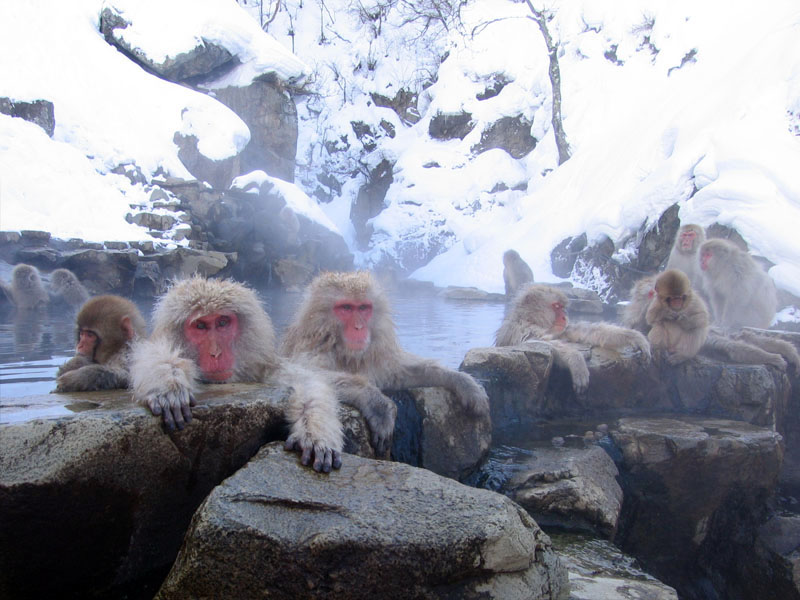We've said it several times: This blog does not have enough monkeys. The author is not particularly fond of most of them. So, when an interesting monkey comes along, you know it had better be a darn cool monkey.

The Japanese macaque is, in fact, the coolest monkey. Besides being from Japan (which is already pretty cool), it is not on the endangered list, can eat almost anything, and enjoys plenty of popularity in Japan's native culture. Yes, we know the Chinese Zodiac was made in China, and so was Journey to the West- the basis for the ever popular Dragon Ball series. They are, however, featured in a few Japanese folktales and can be used to describe particularly affectionate or horny people.
Japanese macaques are the only primates native to a cold climate. Aside from humans, no other primate lives as far north as the macaques. (Seriously, look on a map - Japan is pretty far north compared to Africa and the Amazon, two other places famous for monkeys.) Japanese macaques can be seen huddling together in blizzards for warmth, although we are pretty sure that having fur helps, too. The constant use of their wintery image has sometimes led to them being called "snow monkeys."
The snow monkeys also happen to be super intelligent - even by monkey standards. They have been observed washing food like raccoons - repeatedly. Groups of macaques mere miles apart can have amazingly different dialects. As play is a sign of intelligence, these monkeys have been known to roll in the snow and make snowballs (which are far more sanitary to throw than certain other things). By the way, these monkeys also like hot springs in winter- just like people!

Much to the delight of feminists everywhere, Japanese macaque groups are matrilineal. Everything in a macaque clan centers around the female. When time comes to mate, the female decides, making, ah, nonconsensual sex apparently nonexistent. They can and will mate with multiple males when the time is right. They're even more vocal; like women at a beauty parlor, these monkeys will chatter to each other while grooming. Before you ask: Yes, these monkeys do have lesbians.
Prior to WWII, the biggest threat to these monkeys was habitat loss. As civilization continues to expand, humans will encroach upon the territories of these monkeys. Macaques on the edge of civilization have completely lost their fear of humans. There was one instance of a monkey living in central Tokyo for months. Whether this newly-found proximity is a good or bad thing remains to be seen. Let's hope that they do not become as naughty as the Japanese crows...

The Japanese macaque is, in fact, the coolest monkey. Besides being from Japan (which is already pretty cool), it is not on the endangered list, can eat almost anything, and enjoys plenty of popularity in Japan's native culture. Yes, we know the Chinese Zodiac was made in China, and so was Journey to the West- the basis for the ever popular Dragon Ball series. They are, however, featured in a few Japanese folktales and can be used to describe particularly affectionate or horny people.
Japanese macaques are the only primates native to a cold climate. Aside from humans, no other primate lives as far north as the macaques. (Seriously, look on a map - Japan is pretty far north compared to Africa and the Amazon, two other places famous for monkeys.) Japanese macaques can be seen huddling together in blizzards for warmth, although we are pretty sure that having fur helps, too. The constant use of their wintery image has sometimes led to them being called "snow monkeys."
The snow monkeys also happen to be super intelligent - even by monkey standards. They have been observed washing food like raccoons - repeatedly. Groups of macaques mere miles apart can have amazingly different dialects. As play is a sign of intelligence, these monkeys have been known to roll in the snow and make snowballs (which are far more sanitary to throw than certain other things). By the way, these monkeys also like hot springs in winter- just like people!

Much to the delight of feminists everywhere, Japanese macaque groups are matrilineal. Everything in a macaque clan centers around the female. When time comes to mate, the female decides, making, ah, nonconsensual sex apparently nonexistent. They can and will mate with multiple males when the time is right. They're even more vocal; like women at a beauty parlor, these monkeys will chatter to each other while grooming. Before you ask: Yes, these monkeys do have lesbians.
Prior to WWII, the biggest threat to these monkeys was habitat loss. As civilization continues to expand, humans will encroach upon the territories of these monkeys. Macaques on the edge of civilization have completely lost their fear of humans. There was one instance of a monkey living in central Tokyo for months. Whether this newly-found proximity is a good or bad thing remains to be seen. Let's hope that they do not become as naughty as the Japanese crows...



No comments:
Post a Comment